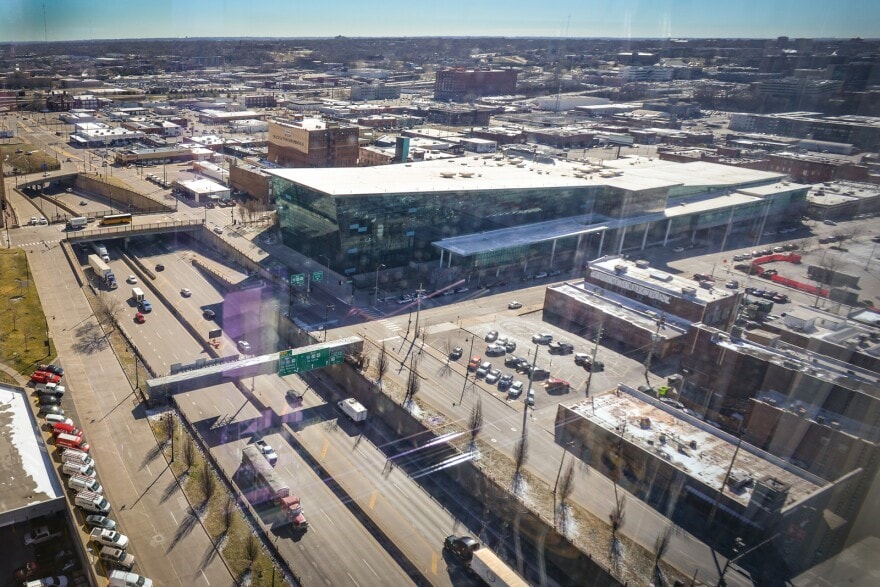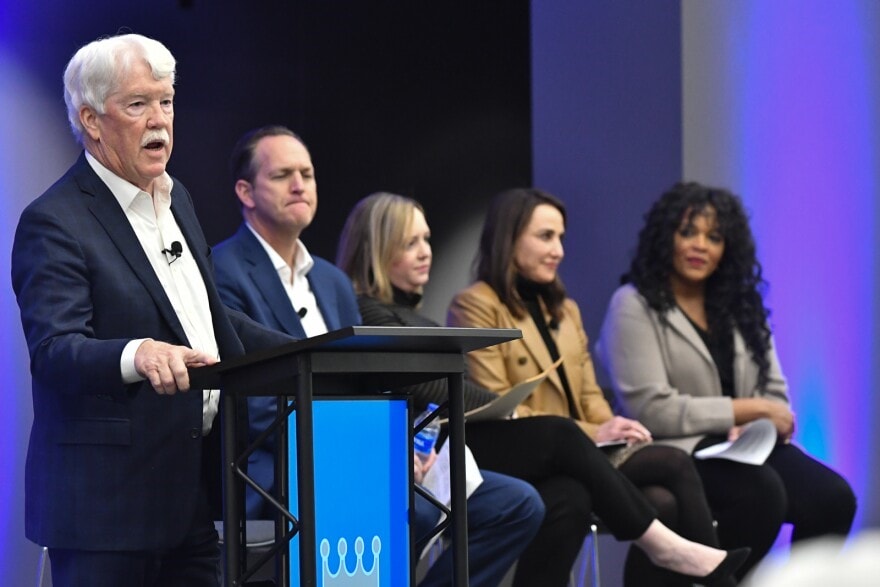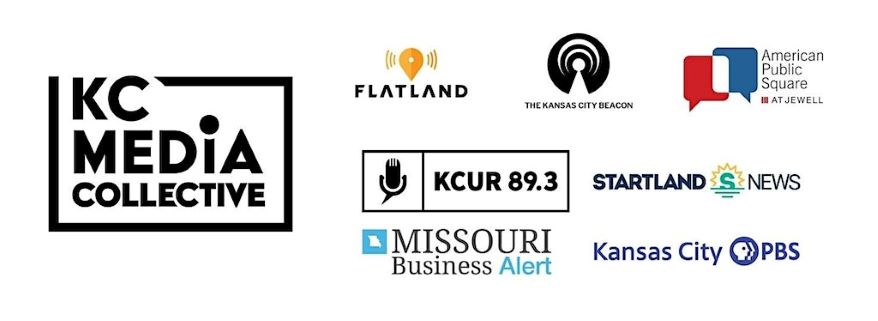Kansas City Chiefs and Royals say Stadium Deals Will Help the Community. Economists Disagree The teams call the deals historic. Community groups and economists aren’t so sure.
Published March 25th, 2024 at 11:59 AM
Above image credit: A view looking north from the proposed Kansas City Royals ballpark with the downtown skyline in the background. (Courtesy | Populous)The Kansas City Royals and Chiefs announced last week that they had finalized a community benefits agreement with Jackson County ahead of the April 2 vote on a sales tax to fund renovations at Arrowhead Stadium and a new baseball stadium downtown.
If the sales tax passes, the teams pledged hundreds of millions of dollars that would be split among various initiatives. They also promised minority- and women-owned companies would get up to 43% of the business during and after stadium construction.
The deal is not yet binding, and the Jackson County Legislature must vote on whether to approve it. No date for that meeting has been announced.
DaRon McGee, the county’s 4th district legislator, was involved in negotiations and said the agreement between the teams and the county is “historic.”
“If you look at the areas in which they are trying to benefit our community and education, health, and those areas, I think that this is a step in the right direction,” McGee said. “Now, is it perfect? No. But I think it addresses strong community needs and it has a strong community impact for years to come.”
As of late last week, the teams were still in the process of negotiating agreements with the Crossroads Community Association, Arts KC, and Kansas City Public Schools.
Though the teams’ proposed agreement with Jackson County is final, it is still contentious. Some community groups that left negotiations say it doesn’t go far enough, while McGee and other Jackson County legislators, along with the teams, say it’s a great deal. Jackson County Executive Frank White, who vetoed putting the tax on the ballot, said he was left out of negotiations.
Here’s what’s in the deal:
- The Royals pledged 33% minority-owned and 10% women-owned business participation during the construction period and then 30% minority-owned and 10% women-owned business participation on projects after initial construction at the new Royals ballpark. The Chiefs have also pledged 43% minority- and women-owned business participation in construction.
- The Royals pledged $140 million over the life of the 40-year tax, or $3.5 million per year, that could be distributed to nine different initiatives, including affordable housing and public transportation programs.
- The Chiefs pledged $126 million over the life of the 40-year tax, or $3.15 million per year, that could be distributed to nine different initiatives, including employment benefits and education programs.
The funds would be distributed by boards established by the county. The Royals and the Chiefs would appoint 45% of the boards’ members.

What Economists Say
The Royals estimate that the stadium and ballpark district will generate $1.2 billion in annual economic output once the stadium is up and running. But a majority of economists agree that stadiums, no matter their location, do not deliver an economic boon to cities. Often, any money made in a new stadium district isn’t new spending — it’s just moved to a new location.
Much of that estimate is based on the assumption that more fans will come to watch games in a new stadium with, after recent trades, a potentially more winning team.
Multiple studies have shown that any “novelty effect” that brings more fans to a new stadium wears off after just a few years. Decades of research show that there is “no systemic interaction” between a new stadium and better team performance or attendance.
Greg LeRoy is the director of the Good Jobs First nonprofit. His organization has spent decades tracking state and local economic development subsidies and wrote some of the country’s earliest definitions of CBAs. LeRoy said the Chiefs’ and Royals’ deal is “laundry-listed with philanthropy,” which makes it look like a public relations move instead of a positive return to the community.
LeRoy said the agreement doesn’t do much for the community and is an example of “what a fake CBA looks like.” But it does make the Royals more valuable.
“These long-term small payments, broadly defined, could be structured as charity,” LeRoy said. “The team is getting those massive tax breaks … which far, far exceed the cost of these donations. Will you get a winning team? Will you get a better neighborhood? Will you get a safer community? Those are all debatable, but it’s virtually a sure lock that you’re going to get a more valuable franchise.”
He said a key issue with the agreement is that it’s primarily between the county and the teams. A community benefits agreement, according to a manual Good Jobs First published two decades ago, is between a developer and private community groups, not primarily negotiated by a governmental entity.

Laura Dresser, a labor economist and associate director for the High Road Strategy Center, has studied these types of agreements in other cities. A good example, she said, is the deal the Milwaukee Bucks made for their new stadium. It included a living wage for stadium and entertainment district workers and a path to unionization.
“A community benefits agreement that attends to the long-term question of the quality of service sector jobs in properties that relate to these giant economic development deals — that’s what I’m always looking for,” Dresser said. “There’s nothing about that in this agreement.”
Dresser said the construction promises for minority- and women-owned businesses are a good start, but this agreement doesn’t provide substantial progress to those who will work in the stadium and entertainment district long-term.
Victor Matheson, a sports economist and professor at the College of the Holy Cross, said the biggest issue with the agreement is its “vague goals” for funding with the annual $3.5 million. Like LeRoy, Matheson’s biggest takeaway is that “this community benefits agreement is entirely PR.”
“They come off saying, ‘Hey, we’re a really good corporate citizen because we are going to give $3.5 million a year — that we are going to have a great deal of input about how that money gets spent.’ And in exchange for that, all we want you to do is give us $27 million a year.”
Matheson said Jackson County might be better served by cutting out the middle man and raising a 3/8th-cent sales tax that gives more each year to those same community interests the Royals would fund with this agreement.
“These tend to be very poor investments that tend to be extremely good at making team owners rich,” Matheson said. “They’re not particularly great for improving the economy or providing significant resources to disadvantaged communities.”

Community Groups’ Response
Several of the community groups associated with the county agreement — MORE2, the Missouri Workers Center and the Heartland Center for Jobs and Freedom — left the negotiations because they said the Royals reduced affordable housing and labor proposals.
“The low-wage workers and tenants we represent are worth more, which is why the Royals — after our every effort over the last year to arrive at a fair CBA with living-wage union jobs and truly affordable housing — left us no choice but to walk away from their bad faith negotiations,” the Missouri Workers Center and Heartland Center for Jobs and Freedom said in a statement.
Lora McDonald, the executive director of MORE2, a faith-based organization focused on racial equity, said her group was “sidelined” after months of talks. She said she admires the high percentage of minority- and women-owned businesses that will be a part of the project but that the agreement doesn’t go far enough.
McDonald said $3.5 million, “while that’s a large amount of money to me personally in my world, it’s teeny tiny and minuscule compared to the amount of money that it’s going to cost the community to build that stadium. To me it’s a pittance and it’s a little insulting.”
Former Kansas City Mayor Sly James is consulting with the teams’ Vote Yes campaign. He said the Royals weren’t obligated to negotiate with every community group that wanted promises.
“A whole lot of groups came out of the woodwork saying, ‘We want this, we want that.’ When you totaled it all up, it was a number that couldn’t be met,” he said.
“You can’t negotiate with everybody. We negotiated with the people that we needed to negotiate with. That was the county. It was the county who is a signatory to the CBA, not the tenants, not the (Missouri Workers Center), not whoever else is out there. It’s the county because that’s who owns the stadiums.”

Where Other Agreements Stand
While James says the Royals are still negotiating more community agreements, Kansas City Public Schools said their deal fell through.
KCPS said it’s finalizing a deal to ensure it doesn’t lose existing property tax revenues from the stadium footprint, but was unable to come to an agreement with the team for long-term demands such as paying for literacy coaches and tutoring — programs that are currently funded with federal COVID-relief dollars. The district also requested financing for a youth housing program.
“We acknowledge that the county-negotiated CBA will include dollars for education and we are committed to being good partners with those working on education initiatives in Kansas City,” the district said in a statement.
“However, there is no guarantee of support for KCPS. We had advocated for a KCPS Community Benefits Agreement to secure the type of direct investment that would substantially move the needle on literacy in Kansas City.”
KCPS was able to secure a guarantee from the Royals that the district would not lose property tax funding throughout the life of the tax and that 3-5 students would get paid internships for 10 years.
James says an agreement with ArtsKC would help fund arts and entertainment in the Crossroads, Westside and 18th and Vine neighborhoods.
The Crossroads Community Association is working to establish a binding agreement before the April 2 election. It is seeking funding from the Royals for five focus areas including small businesses, a Crossroads Community Improvement District and the arts.
Savannah Hawley-Bates is a reporter for KCUR 89.3, where this story first appeared. KCUR is a member of the KC Media Collective.





